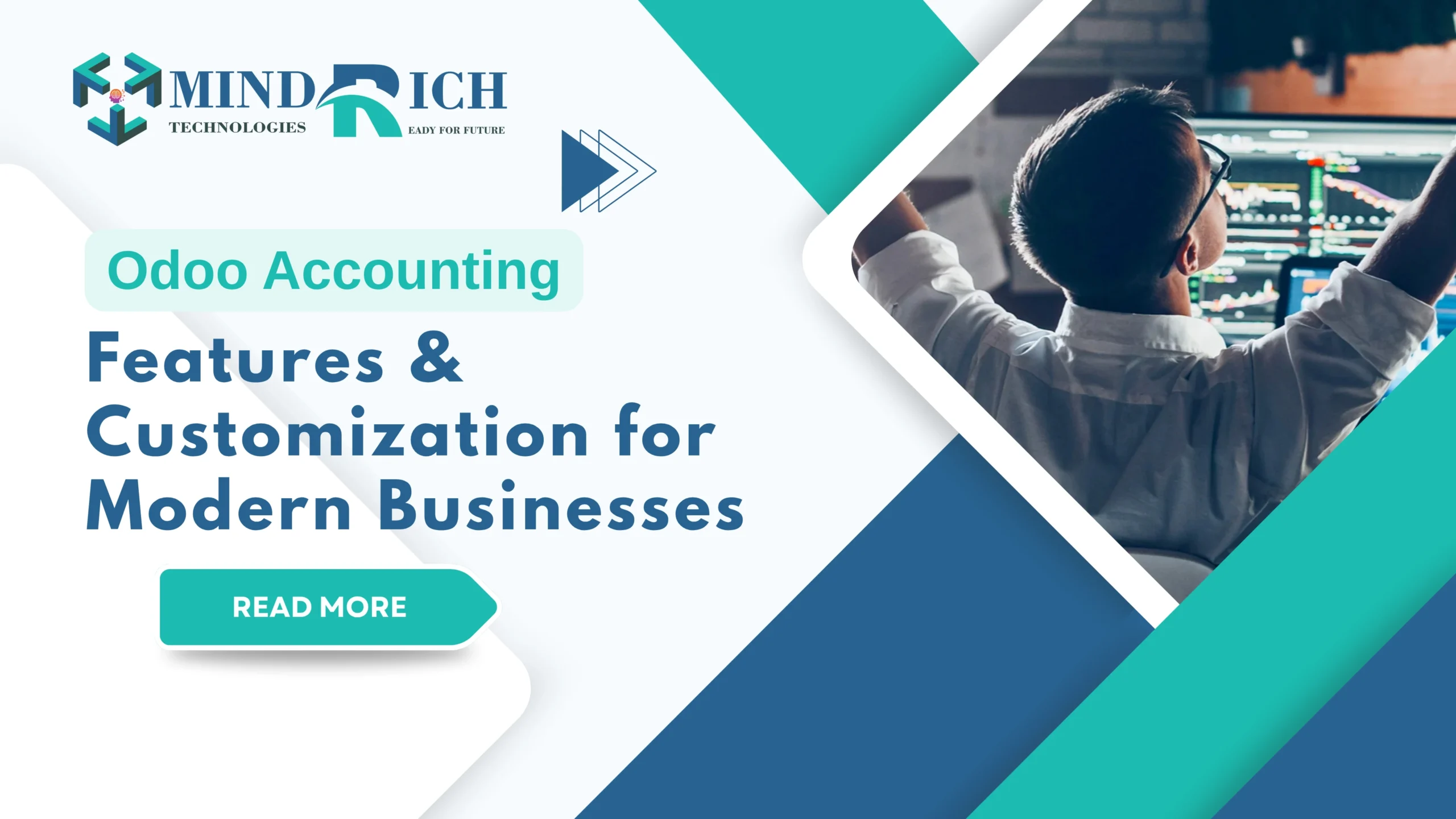Accounting is the heartbeat of every organization. When your finance engine runs smoothly, leadership gains real-time clarity, stakeholders stay confident, and growth decisions become data-driven. Odoo Accounting – part of the open-source Odoo ERP suite – offers an elegant blend of automation, compliance, and flexibility that rivals expensive legacy systems. Even more, companies may customize each interface, workflow, and report thanks to its modular architecture. For businesses of all sizes, Odoo Accounting stands out as a reliable, adaptable, and scalable solution. We’ll go over Odoo Accounting’s main features, its customization options, and how it may transform your financial management in this blog.
About Odoo Accounting
Odoo Accounting is complete financial management software within the Odoo ERP and enables companies to perfectly manage their day-to-day accounting-from invoicing and payment up to tax reports and financial statements. Integrate nicely with the other modules, such as Odoo Sales, Inventory, and HR to form a complete financial ecosystem for your business.
With support for multiple currencies, global tax compliance, and bank synchronization, it’s built to meet the demands of both local and international businesses.
Read More: What is Accounting Software? It’s Features, Benefits & More
Odoo Accounting Features
- Accounts Receivable (A/R)
| Features | Why It Matters | Quick Win |
| Automated Invoice Drafts | Generates invoices from SOs, subscriptions, timesheets | Set fiscal positions to auto-populate tax codes |
| Smart Follow Ups | Scheduled emails, SMS, and WhatsApp reminders | Use dunning levels to escalate tone |
| Customer Portal | Self-service downloads & payments | Embed Stripe, Razorpay, or other payment gateways in 5 min |
- Accounts Payable (A/P)
- Vendor Bills OCR: Drag-and-drop PDF bills can be used for vendor bill OCR, and Odoo can accurately extract the supplier, date, amount, and GSTIN with ±98% accuracy.
- Batch Payments: Create SEPA, ACH, or UPI files and send them to your bank to make batch payments.
- Early-Payment Discounts: Set up automatic deductions in the event that bills are paid prior to the schedule.
- Bank, Cash & Reconciliation
- Smart reconciliation: With just one click, you can accept journal entries that Odoo’s matching engine suggests based on amount, partner, and label.
- Split and partial payments: One statement line can be divided among several accounts, and a single customer payment can pay many bills.
- Cash registers & petty cash: Simple opening/closing balance wizard for retail or field offices.
- Taxes & Compliance
- Country-ready fiscal localizations with pre-loaded tax codes and e-invoicing where required.
- Automated tax reports: GST R-1, R-3B, GSTR 9, EU VAT return, 1099 (US) … generated from live data.
- Digital signatures & audit trail: each entry carries user/time stamps; PDF invoices can be digitally signed.
- Multi-Everything
| Scope | Feature |
| Multi-currency | Real-time FX rates; realised/unrealised gains posted automatically |
| Multi-company | Separate charts of accounts + consolidated groups; inter-company invoicing in two clicks |
| Multi-Language | User interface + customer-facing docs translated; language auto-picks by partner |
- Analytics, Budgets & Assets
- Analytic (cost-center) accounting – tag any line with project, department, campaign; pivot instantly.
- Budgets – create, track, and get email alerts when spending deviates.
- Asset management & depreciation – straight-line, written down balance, custom schedules; automatic journal entries.
- Deferred revenues & expenses – useful for maintenance contracts, insurance, rent, etc.
- Dynamic Reporting
| Report | Highlights |
| General ledger, Trial balance, Journal audit | Filterable, drill-down to source move with one click |
| P&L / Balance Sheet / Cash-flow | Real-time, multi-level groups, comparison columns, export to Excel |
| Executive summary | KPI dashboard |
| Custom dashboards | Any report view can be saved as a tile; schedule PDFs to managers’ inbox weekly |
- Automation & Quality-of-Life Extras
Scheduled dunning with escalating email templates and optional automatic late-payment fees.
- Chatter & @mentions on every document keep audit conversations inside the system.
- Inter-module hooks: include timesheet re-invoicing , inventory valuation entries, and subscription renewals.
- Mobile app – Snap a vendor bill photo, approve payments, or review P&L on the go.
- Spreadsheet (Odoo Sheet) – Live accounting data inside a Google-Sheets-style editor for ad-hoc analysis.
- Security & Audit
- Fine-grained access rights (e.g., accountant sees everything, sales manager sees only invoices).
- Period lock-date to freeze prior fiscal years.
- Audit log and immutable “posted” state – any change creates a reversal + new move, satisfying IFRS & GAAP.
- Typical ROI Users Report
| Pain point before Odoo | Improvement after rollout |
| Manual invoice creation (5 min each) | ~85 % time save |
| Month-end close 10-12 days | 3-5 days with live reconciliation & scheduled accruals |
| Frequent Excel errors in GST return | One-click GSTR‐3B using certified localization |
Curious About What is Odoo Software? The Ultimate Guide to Odoo ERP
Customization in Odoo Accounting
Odoo Accounting is powerful out-of-the-box, but what truly sets it apart is its extensive customization capabilities. Businesses across industries often have unique financial workflows, compliance requirements, and reporting formats. Odoo’s modular and open-source architecture makes it easy to mold the accounting module as per those needs.
This is a summary of the customization options available for Odoo Accounting:
1. Chart of Accounts (COA) Customization
The foundation of any accounting system is the Chart of Accounts. Odoo allows:
- Creation of a custom chart of accounts from scratch or modification of existing ones.
- Mapping specific accounts to taxes, products, or journals.
- Grouping accounts for reporting purposes.
Use Case: A manufacturing company may create separate accounts for raw materials, semi-finished goods, and finished goods.
2. Custom Invoicing and Billing Templates
Odoo lets you design custom invoice and bill layouts using:
- QWeb templating language (technical customization).
- Odoo Studio (no-code customization).
You can add:
- Custom branding (logos, fonts, headers).
- Payment QR codes or barcodes.
- Additional fields like delivery notes, contract details, or dynamic terms & conditions.
3. Automation of Financial Workflows
With the Automated Actions feature or through Python scripting, you can automate:
- Sending follow-up reminders for overdue payments.
- Validating journal entries when conditions are met.
- Generating recurring invoices (e.g., for subscriptions).
- Auto-posting of deferred revenue or prepaid expenses.
4. Custom Reports and Dashboards
Standard financial reports (P&L, balance sheet, etc.) are available in Odoo, but you can also create:
- Customized reports with additional filters (e.g., department-wise expenses).
- Dashboards created with Odoo Studio or BI software (via API).
- Comparative analysis reports across companies, periods, or projects.
5. Analytic and Cost Center Configuration
Odoo provides Analytic Accounting, but you can customize it further:
- Create multiple analytic accounts and tags.
- Assign them to transactions via rules.
- Configure cost centers for departments, regions, or teams.
6. Tax and Fiscal Position Customization
You can:
- Define multiple tax structures (e.g., GST).
- Create fiscal positions that dynamically change tax rules based on customer location or product category.
- Customize tax invoice formats and return reports for compliance.
7. Journal and Entry Customization
Odoo journals can be customized to satisfy particular operational or regulatory requirements:
- Custom journal sequences.
- Special journals for asset depreciation, deferred revenue, or intercompany transfers.
- Modify journal entry views with additional fields (e.g., reference numbers, approval checkboxes).
8. Payment Gateway and Bank Integration
Odoo supports many payment gateways, but you can:
- Add new gateways via custom modules.
- Customize the import formats for bank statements (such as Excel).
- Integrate directly with bank APIs for real-time reconciliation.
9. Permissions and Role-Based Access
You can customize user roles:
- Limit who can validate invoices or approve payments.
- Grant read-only access to auditors or consultants.
- Set up approval hierarchies for purchase bills or large payments.
10. Localization and Compliance
Odoo’s open structure lets you:
- Adapt reports for local tax authorities (e.g., GSTR in India, SAF-T in Europe).
- Provide government reporting portals, e-invoicing compliance, or digital signatures.
- Handle fiscal year changes, multi-calendar reporting, and localized currency rounding.
11. Integration with External Tools
Using Odoo’s RESTful APIs or external connectors, you can integrate:
- External CRMs, payroll systems, or ERPs.
- Government GST or VAT APIs.
- Financial planning tools like QuickBooks, Tally, or Zoho.
12. Workflow Approval Customization
For businesses with complex approval needs:
- Set multi-level approval for invoices or payments.
- Trigger different approval paths based on the amount or vendor.
- Log approval history for audit trails.
13. Deferred Revenue and Accrual Customization
You can configure and automate:
- Deferred revenue schedules (e.g., SaaS billing).
- Accrual journal entries for expenses like insurance or rent.
- Monthly posting using predefined templates.
14. Odoo Studio Customization (Low-Code/No-Code)
Odoo Studio allows non-developers to:
- Add or modify fields on invoices, bills, or journals.
- Create approval buttons or automated actions.
- Build new views, forms, or workflows without writing code.
Odoo Integration Playbook
1. E-Commerce
- WooCommerce & Shopify Connectors push orders into Odoo Sales; invoices and payment status sync back.
- Map payment gateways to journal entries automatically.
2. Inventory & Manufacturing
- Real-time stock valuation journals (FIFO, AVCO, Standard).
- Landed cost allocation module to capitalize freight, duties, and insurance.
3. Payroll & HR
- Salary slips post to journals; auto-split into expense, liability, and tax lines.
- PF/ESI & fringe benefits tax rules for India.
4. BI & Analytics
- Odoo Spreadsheet: Excel-like formulae pulling live GL data.
- Power BI Connector: pre-built dataflows for P&L, cash flow, AR ageing.
FAQ For Odoo Accounting
A- Yes. It supports e-Invoicing, e-Waybill, and GST 2.0 returns out-of-the-box.
A- Absolutely. Use CSV import wizards or third-party connectors to transfer ledgers, invoices, and masters.
A- Yes, automatic FX rates, realized/unrealized gains, and multi-company consolidations.
A- The Community edition is free under LGPL. Enterprise adds AI reconciliation, OCR, and official support.
A- Odoo uses role-based access, record rules, 256-bit SSL, and audit logs. Self-hosting lets you comply with local data residency laws.
Final Takeaway
Odoo Accounting isn’t just an invoicing tool; it’s a fully-featured financial cockpit that grows with your ambitions. From automated follow-ups to AI-powered reconciliations and deep Odoo customization, it empowers finance teams to focus on strategy, not data entry.
Ready to modernize your accounting stack? Book a free 30-minute consultation with our Odoo experts, or download our step-by-step migration checklist to start your journey today.










